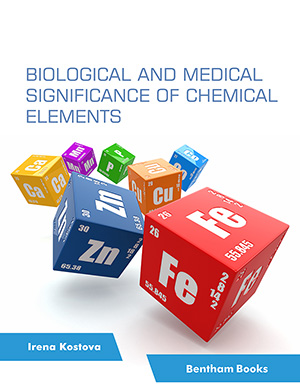Abstract
A photoremovable protecting group (PRPG) is an organic molecular framework that may be cleaved when exposed to light. It allows spatial as well as temporal control over the release of various substances such as neurotransmitters, cell signalling molecules, acids, bases, Ca2+ ions, oxidants, insecticides, pheromones, and perfumes, etc. This minireview highlights the history and current state of the art of several PRPGs in organic chemistry. Synthesis, application and mechanism of cleavage process of PRPGs were also discussed thoroughly in this article.
Keywords: Photoremovable protecting groups, photoreleasable protecting groups, photocleavable protecting groups, photoactivatable protecting groups, photochemistry, neurotransmitter.
[http://dx.doi.org/10.1021/cr300177k] [PMID: 23256727]
[http://dx.doi.org/10.1039/c19660000822]
[http://dx.doi.org/10.1039/b200777k] [PMID: 12659154]
[http://dx.doi.org/10.1021/ja039071z] [PMID: 15070376]
[http://dx.doi.org/10.1021/ja00202a042]
[http://dx.doi.org/10.1021/ja00229a036]
[http://dx.doi.org/10.1002/cbic.200390027] [PMID: 12616629]
[http://dx.doi.org/10.1021/ja0259988] [PMID: 12083919]
[http://dx.doi.org/10.1021/bi00603a020] [PMID: 148906]
[http://dx.doi.org/10.1021/ol070238t] [PMID: 17506572]
[http://dx.doi.org/10.1117/1.1582468] [PMID: 12880347]
[http://dx.doi.org/10.1021/bc970147o] [PMID: 9548528]
[http://dx.doi.org/10.1021/ja01077a046]
[http://dx.doi.org/10.1039/p19920002409]
[http://dx.doi.org/10.1021/ja00048a059]
[http://dx.doi.org/10.1021/ja00067a015]
[http://dx.doi.org/10.1021/ja993070i]
[http://dx.doi.org/10.1021/jo951635x]
[http://dx.doi.org/10.1021/jo00961a027]
[http://dx.doi.org/10.1016/S0040-4039(00)62031-2]
[http://dx.doi.org/10.1021/ja991014b]
[http://dx.doi.org/10.1021/ol005856n] [PMID: 10841475]
[http://dx.doi.org/10.1021/jp010220e]
[http://dx.doi.org/10.1039/B408851D] [PMID: 15616690]
[http://dx.doi.org/10.1039/B208171G] [PMID: 12659533]
[http://dx.doi.org/10.1021/ja00334a075]
[http://dx.doi.org/10.1021/jo9910233]
[http://dx.doi.org/10.1073/pnas.96.4.1193] [PMID: 9990000]
[http://dx.doi.org/10.1002/1521-3773(20010316)40:6<1045::AID-ANIE10450>3.0.CO;2-F] [PMID: 11268067]
[http://dx.doi.org/10.1016/S0009-2614(03)00535-9]
[http://dx.doi.org/10.1006/bbrc.1996.1638] [PMID: 8912658]
[http://dx.doi.org/10.1021/jo00118a008]
[http://dx.doi.org/10.1021/ol026524g] [PMID: 12323033]
[http://dx.doi.org/10.1021/ja0555320] [PMID: 16569001]
[http://dx.doi.org/10.1016/j.tet.2010.08.020]
[http://dx.doi.org/10.1021/ol015787s] [PMID: 11405717]
[http://dx.doi.org/10.1021/jo961638p]
[http://dx.doi.org/10.1021/jo0261193] [PMID: 12608818]
[http://dx.doi.org/10.1002/1521-3773(20021004)41:19<3625::AIDANIE3625>3.0.CO;2-J] [PMID: 12370911]
[http://dx.doi.org/10.1002/(SICI)1521-3765(19990301)5:3<951::AID-CHEM951>3.0.CO;2-G]
[http://dx.doi.org/10.1021/jo010692p] [PMID: 11856009]
[http://dx.doi.org/10.1016/S0962-8924(99)01585-8] [PMID: 10370245]
[http://dx.doi.org/10.1021/ja964427a]
[http://dx.doi.org/10.1002/1522-2675(20011219)84:12<3735::AID-HLCA3735>3.0.CO;2-A]
[http://dx.doi.org/10.1021/ol047729n] [PMID: 15646977]
[http://dx.doi.org/10.1021/ja0351847] [PMID: 12926919]
[http://dx.doi.org/10.1016/S0165-0270(01)00451-4] [PMID: 11640955]
[http://dx.doi.org/10.1562/2004-07-08-RA-226.1] [PMID: 15623351]
[http://dx.doi.org/10.1016/j.tet.2007.07.107]
[http://dx.doi.org/10.1016/S1570-0232(02)00621-9] [PMID: 12450657]
[http://dx.doi.org/10.1016/S0091-679X(08)85003-0] [PMID: 18155458]
[http://dx.doi.org/10.1093/ajcn/80.2.483] [PMID: 15277174]
[http://dx.doi.org/10.1021/jo9702608]
[http://dx.doi.org/10.1016/j.tetlet.2005.06.026]
[http://dx.doi.org/10.1055/s-1991-20619]
[http://dx.doi.org/10.1246/cl.1993.1179]
[http://dx.doi.org/10.1111/j.1751-1097.1995.tb02340.x]
[http://dx.doi.org/10.1016/j.tet.2006.09.085]
[http://dx.doi.org/10.1039/C1PP05317E] [PMID: 22186939]
[http://dx.doi.org/10.1016/j.tet.2010.10.090]
[http://dx.doi.org/10.1016/j.tet.2011.11.074]
[http://dx.doi.org/10.1351/pac199769030413]
[http://dx.doi.org/10.1021/jo302545n] [PMID: 23428314]
[http://dx.doi.org/10.1002/slct.201900779]
[http://dx.doi.org/10.2174/1570178617999200909114431]
[http://dx.doi.org/10.24820/ark.5550190.p010.966]
[http://dx.doi.org/10.1021/ja00070a006]
[http://dx.doi.org/10.1021/jo00058a049]
[http://dx.doi.org/10.1016/S0040-4020(01)00208-3]































